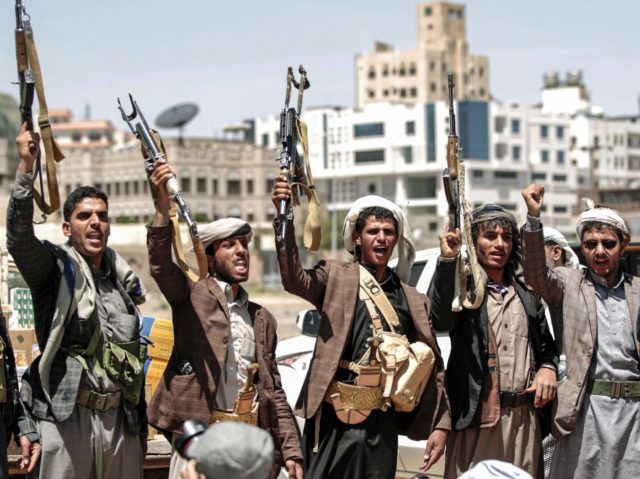
The Houthis’ War to Lose: The Battle for Marib
Publication: Terrorism Monitor Volume: 18 Issue: 6
By:

Yemen’s Houthis have defied the forecasts of numerous analysts who predicted that their grip on northwest Yemen would erode. Rather than being weakened, Houthi and allied forces are stronger and better organized than at any point over the last two years. The Houthis’ recent offensives in the Yemeni governorates of al-Jawf and, now, Marib attest to their continued strength as a cohesive fighting force.
On March 1, Houthi and allied forces seized al-Hazm, the capital of the governorate of al-Jawf. Following the capture of al-Hazm, Houthi and allied forces expanded their offensive and have seemingly retaken most of al-Jawf (Middle East Monitor, March 2). The capture of al-Jawf, which borders Saudi Arabia, will allow the Houthis to push deeper into the energy-rich governorate of Marib (al-Monitor, March 12). Marib is a critical stronghold for the Saudi-backed government of Abd Raboo Mansur Hadi. Control of Marib, or even just parts of it, will not only give the Houthis control of key oil and gas resources, but will also curtail Saudi-backed forces’ ability to attack Houthi positions. Marib city, the capital of the governorate, is home to air and military bases used by Hadi-aligned forces. Without access to these bases, Hadi-aligned forces’ ability to operate in Yemen will be seriously impeded. Marib is also home to tens of thousands of IDPs.
The Houthis advance in al-Jawf and Marib builds on their longstanding strategy of consolidate, hold, and advance. While there have been numerous tactical setbacks over the last year, the Houthis and allied forces have maintained their ability to launch effective and deadly counter-offensives. This was demonstrated in the district of Nihm, which borders the Houthi-held capital of Sana’a. In late January, the Houthis launched a counter-offensive that retook those areas that had been captured by Hadi-allied forces (al-Monitor, February 19). Once they reestablished control, the Houthis used parts of Nihm as a base from which to target Hadi allied forces in al-Jawf.
While the forces who oppose the Houthis possess more advanced weapons, and in theory, air support from Saudi Arabia and the United Arab Emirates (UAE), they do not have a coherent chain of command or effective leadership on the battlefields. [1] Additionally, the Hadi-aligned forces struggle with legitimacy and the maintenance of critical tribal support. In contrast, the Houthis and their allies—which include a significant and growing percentage of the critical “collar tribes” that ring Sana’a—have clear chains of command and broad tribal support. This support is not indicative of support for the “Houthi movement.” It is more likely that this support reflects tribal elites betting on those forces they think will win. This support is also based on the Houthis’ ability to successfully buy and coerce the support of key tribal power brokers.
Just as Yemen’s former president, Ali Abdullah Saleh, did, the Houthis apply a carrot and stick approach to gain and maintain tribal support. Tribal and political elites who support the Houthis are included in the lucrative legal and illegal trade in gasoline, propane, food, and medical supplies. Those who support them are also incorporated—to a limited degree—into the Sana’a-based government. Elites who do not support the Houthis are subject to kidnapping, harassment, prosecution, and assassination (Arab News, March 4). The Houthis are increasingly heavy-handed in those areas that they control. However, at least for now, they seem to understand what Ali Abdullah Saleh long understood: there are lines that are not to be crossed without consequences. The de-facto sovereignty of tribal elites is generally respected in those areas that they govern.
In contrast, the Hadi-aligned government in exile has struggled with both legitimacy and with gaining consistent support from key tribal elites based in northwest Yemen. Even in Marib, the Hadi-backed forces are finding it difficult to maintain support. This is despite the fact that Saudi Arabia has flooded the governorate with money—money that has turned Marib into something of a boomtown. Marib-based tribal elites are politically and tactically sophisticated and have a long history of out-maneuvering outsiders. If the Houthis and their allies manage to make significant headway in Marib, there may be a sudden and dramatic shift in alliances. The Houthis are just as politically adept and will undoubtedly make promises that will interest Marib’s elites more than a protracted battle.
The forces opposing the Houthis in Marib are largely composed of men brought in from other governorates around Yemen. They are poorly paid, organized, and led, but most critically, they are outsiders. The web of alliances and loyalties in Marib will disintegrate if it comes under sustained pressure from a Houthi advance. Even with air support, it is unlikely that these forces will be able to hold all of Marib. Without its base in Marib, the Saudi-backed Hadi alliance will become more irrelevant than it already is to the unfolding wars in Yemen.
For months, Saudi Arabia has been scaling down the funding of its war in Yemen. Given the plummeting oil price, a global pandemic, and the unfolding financial crisis, the Kingdom and the UAE will likely begin re-evaluating their expensive and counter-productive policies in Yemen. The only thing likely to stop the Houthis from retaking most, if not all, of northwest Yemen is their own hubris. In Sana’a and in other areas, there is mounting evidence that the Houthis are becoming ever more oppressive and extractive. However, for now, the Houthis and their allies remain the most cohesive and militarily capable force in Yemen. It is their war to lose.
Notes
[1] The UAE, Saudi Arabia, and those forces they back have struggled to establish coherent and effective chains of command across areas of operation since their interventions began in March 2015. See: https://ctc.usma.edu/can-uae-security-forces-avoid-wrong-turn-yemen/




